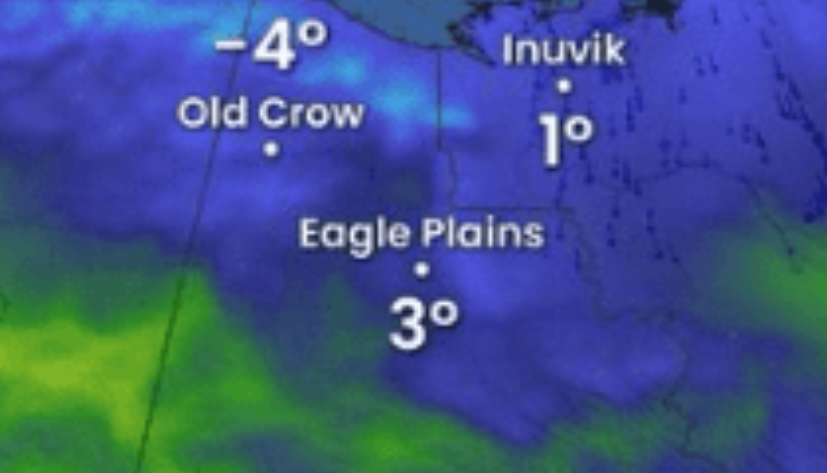
Canada’s Weather Whiplash Shocks Northern Territories
The northern community of Old Crow in Yukon has just endured one of the most dramatic weather reversals in recent memory. After basking in near-30°C summer heat over the weekend, residents awoke just a day later to the reality of snowfall and wintry winds—in the middle of July.
From Scorching Heat…
The summer sun was in full force last weekend. On Saturday, July 5, Old Crow recorded a temperature of 28.1°C, and by Sunday, it had surged to 29.7°C—just shy of the 30-degree threshold. This heatwave wasn’t an isolated incident; it was part of a broader dome of high pressure that brought intense warmth across much of Northern Canada.
As a result, heat warnings were issued by Environment and Climate Change Canada (ECCC) for the Old Crow region, urging residents to stay hydrated and avoid prolonged exposure to the sun.
…To a Wintry Whiteout
But by Tuesday, July 8, everything changed. Arctic winds off the Beaufort Sea surged southward, increasing in intensity and sweeping cold air deep into the Yukon. This influx of frigid air didn’t just bring a chill—it ushered in a full-scale wintry mix, including flurries and accumulating snow.
Within 24 hours, ECCC canceled the heat warnings and issued a Special Weather Statement warning of snowfall and below-freezing wind chills, set to last through Wednesday afternoon. The seasonal switch was so swift and severe that locals described it as a kind of “weather whiplash.”
A Broader Pattern Across Canada
This anomaly in Old Crow isn’t an isolated case. Banff, Alberta, also saw snowfall on Thursday, July 10, captured in live webcam images from the Sunshine Village Ski Resort. A thin layer of snow dusted the mountaintops while low-hanging clouds draped the landscape in a scene more fitting for November than July.
“Yep, this is a LIVE shot from our webcam taken at 12:26 on Thursday,” Banff Sunshine Village confirmed via Facebook, sharing visuals of the unseasonal snowfall on Goat’s Eye Mountain. By afternoon, most of the snow had melted—except for a shaded patch beneath the ski lift and a dusting on rooftops.
A Nation of Extremes
This stark contrast—sun and sizzle on one day, flurries and frost the next—has become a defining feature of Canadian summers. In Alberta, the adage “If you don’t like the weather, wait five minutes” is proving true once again. Just one day before the snow, parts of the province were bracing for large hail and even tornado threats.
Alberta has seen summer snow before. In fact, some areas reported 30 cm of snow earlier this summer. And in June 2024, towns like Bragg Creek, Banff, and Canmore experienced a “Christmas in June” snow event.
What’s Behind This?
These weather swings are rooted in complex atmospheric dynamics. Northern Canada is particularly sensitive to shifts in pressure patterns. When polar air masses slip southward due to disturbances in the jet stream, they can collide with warm summer ridges, producing explosive temperature swings.
Climate variability is also playing a role, increasing the likelihood of these extreme juxtaposed events—heatwaves and cold snaps occurring back-to-back.
Impacts and Takeaways
- Residents in Old Crow are now contending with slippery roads, frosted landscapes, and a hard stop to summer activities.
- Tourists in Banff were surprised by the wintry views—and some delighted in taking photos of snowy peaks under July skies.
- Forecasters warn that more atmospheric instability may affect western and northern regions in the coming weeks, with severe storms, hail, and unusual cold snaps all possible.
Conclusion
The sudden shift from +30°C to snow in Old Crow is a powerful reminder of just how unpredictable Canadian weather can be—especially in the North. For residents and meteorologists alike, it’s yet another case study in the chaotic potential of climate systems in a warming world.
From shorts to snow boots in a day—Canada proves once again that anything is possible when it comes to weather.

Source: Weather Network.


























